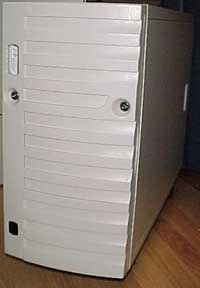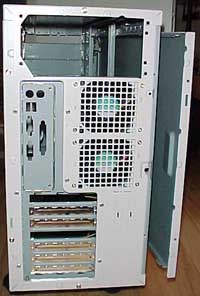Enlight EN-8950 Server Extended ATX
by Anand Lal Shimpi on September 15, 1999 4:28 PM EST- Posted in
- Cases/Cooling/PSUs
The first thing you'll notice about the 8950 is its height, the 16.9" 8950 is just five tenths of an inch taller than the Palo Alto PA-600, a Mid-Tower ATX case designed for single processor desktop systems. What's the killer? The 8950 is a server case capable of accepting extended ATX motherboards, in other words, the boards that you wouldn't dream of sticking in your Mid-Tower ATX cases.
The trick to Enlight's success in making the 8950 a short case is what quite a few server case manufacturers tend to do, make the case greater in depth than it is tall. While hardcore hardware enthusiasts might find this approach "wimpy" in the bigger is better world of tweaking, server admins will appreciate Enlight's approach as it is easier to tuck the 8950 away in a crowded data center than it is to fit a much larger case. And in the server world, although bigger may be better, it also costs quite a bit more as real estate in those data centers isn't a cheap commodity.
 The 8950 weighs in at a fairly light 35
pounds (light for a server case), and features a primarily steel chassis. Once
again, when dealing with a server motherboard, the same principles that apply to cases for
desktop/office use don't apply so you won't be finding much plastic on this case.
The front of the case is the only place you'll find something that can break after being
hit, the plastic front door.
The 8950 weighs in at a fairly light 35
pounds (light for a server case), and features a primarily steel chassis. Once
again, when dealing with a server motherboard, the same principles that apply to cases for
desktop/office use don't apply so you won't be finding much plastic on this case.
The front of the case is the only place you'll find something that can break after being
hit, the plastic front door.
The front door is a two-way swinging door that locks on both sides, unlocking either the left or the right side will allow you to swing the door in either direction. Unlocking both sides will allow the door to be completely removed off of its plastic hinges. The door snaps in tightly to the hinges and requires force to make it swivel to either side once it is unlocked, so you can leave it unlocked without worries of the door flying open when it shouldn't. The front door is made of solid plastic and won't chip easily and also provides an air intake to aid in the cooling of this server case. On the opposite side of the front door are three filter panels that help keep the intake from bringing in too much dust and debris as they are so prone to do in computers that are on 24 hours a day, 7 days a week, aka, a server.
The front of the 8950 is left completely unpopulated with any buttons on the front courtesy of the door, however directly behind the front door are the power, reset and alarm buttons. The reason for not putting them on the front door is obvious, since this case is designed primarily for use in a server environment, it wouldn't be too good of an idea to place a power or reset switch on the outside of the case where it could easily get bumped and thus toss a website or file server off line for a few minutes or at least until someone realizes the problem. However, for those looking for a roomy case for a personal workstation, this can be considered a downside as it forces you to open up the front door of your case just to turn it on, reset it, or even gain access to any of the drive bays.
Visible through the front door
courtesy of a plastic window are the 10 LEDs that are both good attention grabbers and
very useful in terms of the information they can provide. The standard power and HDD
activity LEDs are present here however we also see the inclusion of a LAN activity LED
connector a feature starting to show up on some desktop OEM cases and even in certain
models of IBM's Pentium III line of business computers. 
The LAN activity LED is an innovation that is long overdue and it is good to see that Enlight has included such a useful LED on the 8950. Being a server case, it makes quite a bit of sense for Enlight to include the LED however the biggest questions are "When will we see LAN activity LEDs added on to mainstream cases?" and "What Ethernet cards support it?" The answer to the first question is, hopefully soon. With the increasing numbers of "regular" users making use of Ethernet connections, either for internet connectivity or for use with private networks, it makes perfect sense to include a front panel LAN activity LED. Most Ethernet cards don't have a connector for an external LED and until the standard is set to include support for either a connector or an indicator it is unlikely that we will see any growing support for a connector on the cards anytime soon.
Towards the lower part of the front door is a window for an IR port so communication between another IR device and your system built in the 8950 can be made without having to open the door at all, a wise consideration on the part of Enlight.
With ease of installation not a primary concern for Enlight with the 8950, it comes as no surprise that the design of the case isn't a screw-less one however they did make accessing the inside of the case a somewhat simple task. The case features the same three panel enclosure design that we're used to, the left and right side panels are attached via two phillips head screws each and the top panel is attached via a single screw. Removing the panels after unscrewing them from the rest of the chassis just involves pulling them back slightly and lifting them out of the case itself, the construction of the case makes for an easy removal of both side panels without having to fight with the case at all.
The rear of the case features the standard ATX I/O shield cutouts as well as two SCSI port cutouts which is another feature we unfortunately don't see in many standard ATX cases, if we were to give the example of what the perfect enthusiast's Mid-Tower ATX case would be like, it would end up with quite a few of the features the Enlight 8950 boasts as an entry level server case.
As with most server cases, the 8950 does offer built in electrical chassis intrusion detectors as well as the dual locking front door as mentioned before as two types of prevention against unauthorized case access, which is much more of an important issue when dealing with server cases than with your home computer case. Another feature commonly found with server cases are the four wheels present on the 8950. The two front wheels feature a locking mechanism that effectively prevent the case from rolling when you don't want it to.
 The final point of the design of the 8950
that truly sets it apart from the competition is the fact that the 8950 can
be mounted in a standard 5U-19" rackmount case with the optional rackmount brackets.
This is the explanation behind the weird dimensions of the 8950 in comparison to
other entry level server cases that opt for the larger full tower ATX layouts in order to
provide support for extended ATX motherboards. This convertible approach (offering
both rackmount and standup tower support) is ideal because it addresses the concerns of
users that have to pay for the amount of space they occupy on a rackmount (try sticking a
full tower ATX case in a rack mount, it's not the most practical of ideas) while at the
same time making sure that it isn't a rackmount only solution for those users that aren't
required to install it in a rackmount. Smart thinking on Enlight's part.
The final point of the design of the 8950
that truly sets it apart from the competition is the fact that the 8950 can
be mounted in a standard 5U-19" rackmount case with the optional rackmount brackets.
This is the explanation behind the weird dimensions of the 8950 in comparison to
other entry level server cases that opt for the larger full tower ATX layouts in order to
provide support for extended ATX motherboards. This convertible approach (offering
both rackmount and standup tower support) is ideal because it addresses the concerns of
users that have to pay for the amount of space they occupy on a rackmount (try sticking a
full tower ATX case in a rack mount, it's not the most practical of ideas) while at the
same time making sure that it isn't a rackmount only solution for those users that aren't
required to install it in a rackmount. Smart thinking on Enlight's part.













0 Comments
View All Comments